Study on the Energy Absorption Performance of Triply Periodic Minimal Surface (TPMS) Structures at Different Load-Bearing Angles
Abstract
:1. Introduction
2. Materials and Methods
2.1. Selection of Materials
2.2. Design of TPMS Structures
2.3. Fabrication of TPMS Samples
2.4. Quasi-Static Compression Test
3. Results and Discussion
3.1. Analysis of Experimental Results
3.2. Analysis of Deformation Behavior
4. Conclusions
- Adjusting the load-bearing angles of the Gyroid, Diamond, and IWP structures resulted in distinct responses of energy absorption under quasi-static compressive loads. The performance of energy absorption of the Gyroid structure remained the most stable when changing the load-bearing angle, maintaining nearly consistent capability for energy absorption at all angles. For the Diamond structure, similar performances of energy absorption were observed at 0°, 15°, 75°, and 90°. However, there was a significant enhancement in SEA at 30° and 60°, while a notable reduction occurred at 45°. In contrast, the performance in energy absorption of the IWP structure was most sensitive to changes in the load-bearing angle. It maintained good performance in energy absorption only at 0° and 90°, with a substantial decrease in the capabilities for energy absorption at other angles. Additionally, the SEA of all three structures exhibited a symmetrical pattern centered at 45°.
- Under compressive loading, the deformations of the Gyroid structure were primarily characterized by bending. Similarly, the behaviors of bending-dominated deformation were predominantly shown by the Diamond structure at 0°, 15°, 75°, and 90°. However, at 30° and 60°, a mixed mode of bending and tensile deformations was displayed within the Diamond structure, thereby introducing a secondary plateau of energy absorption that effectively increased the plateau stress of the structure. At 45°, significant strain hardening was demonstrated. As for the IWP structure, its deformation exhibited typical characteristics of tensile deformation under compressive loads. Apart from maintaining good capabilities for load-bearing at 0° and 90° through its structural struts, evident failures of local buckling were shown at other loading angles, which weakened the capacity of overall load-bearing, thereby reducing its plateau stress and capabilities of energy absorption.
- When the deformation mode of the TPMS structures was primarily tensile, a stronger load-bearing capacity was exhibited. Consequently, a higher capacity of specific energy absorption was exhibited. In contrast, compared to structures primarily deforming through tensile, higher stability under multidirectional loads can be shown in those primarily deforming through bending. In summary, although structures that rely on bending deformation may not perform as well as those that rely on tensile deformation on energy absorption, they can provide better stability. Additionally, structures primarily deforming through tensile deformations may have poorer stability, but their potential for energy absorption was higher.
Author Contributions
Funding
Institutional Review Board Statement
Informed Consent Statement
Data Availability Statement
Conflicts of Interest
References
- Yuan, L.; Ding, S.; Wen, C. Additive manufacturing technology for porous metal implant applications and triple minimal surface structures: A review. Bioact. Mater. 2019, 4, 56–70. [Google Scholar] [CrossRef] [PubMed]
- Yang, E.; Leary, M.; Lozanovski, B.; Downing, D.; Mazur, M.; Sarker, A.; Khorasani, A.; Jones, A.; Maconachie, T.; Bateman, S.; et al. Effect of geometry on the mechanical properties of Ti-6Al-4V Gyroid structures fabricated via SLM: A numerical study. Mater. Des. 2019, 184, 108165. [Google Scholar] [CrossRef]
- Feng, J.; Fu, J.; Yao, X.; He, Y. Triply periodic minimal surface (TPMS) porous structures: From multi-scale design, precise additive manufacturing to multidisciplinary applications. Int. J. Extrem. Manuf. 2022, 4, 022001. [Google Scholar] [CrossRef]
- Chen, H.; Liu, Y.; Wang, C.; Zhang, A.; Chen, B.; Han, Q.; Wang, J. Design and properties of biomimetic irregular scaffolds for bone tissue engineering. Comput. Biol. Med. 2021, 130, 104241. [Google Scholar] [CrossRef] [PubMed]
- Maconachie, T.; Leary, M.; Lozanovski, B.; Zhang, X.; Qian, M.; Faruque, O.; Brandt, M. SLM lattice structures: Properties, performance, applications and challenges. Mater. Des. 2019, 183, 108137. [Google Scholar] [CrossRef]
- Riva, L.; Ginestra, P.S.; Ceretti, E. Mechanical characterization and properties of laser-based powder bed–fused lattice structures: A review. Int. J. Adv. Manuf. Technol. 2021, 113, 649–671. [Google Scholar] [CrossRef]
- Laskowska, D.; Szatkiewicz, T.; Bałasz, B.; Mitura, K. Mechanical Properties and Energy Absorption Abilities of Diamond TPMS Cylindrical Structures Fabricated by Selective Laser Melting with 316L Stainless Steel. Materials 2023, 16, 3196. [Google Scholar] [CrossRef] [PubMed]
- Yin, H.; Zhang, W.; Zhu, L.; Meng, F.; Liu, J.; Wen, G. Review on lattice structures for energy absorption properties. Compos. Struct. 2023, 304, 116397. [Google Scholar] [CrossRef]
- Fan, X.; Tang, Q.; Feng, Q.; Ma, S.; Song, J.; Jin, M.; Guo, F.; Jin, P. Design, mechanical properties and energy absorption capability of graded-thickness triply periodic minimal surface structures fabricated by selective laser melting. Int. J. Mech. Sci. 2021, 204, 106586. [Google Scholar] [CrossRef]
- Afshar, M.; Pourkamali Anaraki, A.; Montazerian, H. Compressive characteristics of radially graded porosity scaffolds architectured with minimal surfaces. Mater. Sci. Eng. C 2018, 92, 254–267. [Google Scholar] [CrossRef]
- Wang, Z.; Wang, X.; Gao, T.; Shi, C. Mechanical behavior and deformation mechanism of triply periodic minimal surface sheet under compressive loading. Mech. Adv. Mater. Struct. 2021, 28, 2057–2069. [Google Scholar] [CrossRef]
- Abueidda, D.W.; Elhebeary, M.; Shiang, C.-S.; Abu Al-Rub, R.K.; Jasiuk, I.M. Compression and buckling of microarchitectured Neovius-lattice. Extrem. Mech. Lett. 2020, 37, 100688. [Google Scholar] [CrossRef]
- Yang, L.; Yan, C.; Cao, W.; Liu, Z.; Song, B.; Wen, S.; Zhang, C.; Shi, Y.; Yang, S. Compression–compression fatigue behaviour of gyroid-type triply periodic minimal surface porous structures fabricated by selective laser melting. Acta Mater. 2019, 181, 49–66. [Google Scholar] [CrossRef]
- Keshavarzan, M.; Kadkhodaei, M.; Badrossamay, M.; Karamooz Ravari, M.R. Investigation on the failure mechanism of triply periodic minimal surface cellular structures fabricated by Vat photopolymerization additive manufacturing under compressive loadings. Mech. Mater. 2020, 140, 103150. [Google Scholar] [CrossRef]
- Plocher, J.; Panesar, A. Effect of density and unit cell size grading on the stiffness and energy absorption of short fibre-reinforced functionally graded lattice structures. Addit. Manuf. 2020, 33, 101171. [Google Scholar] [CrossRef]
- Zhao, M.; Zhang, D.Z.; Liu, F.; Li, Z.; Ma, Z.; Ren, Z. Mechanical and energy absorption characteristics of additively manufactured functionally graded sheet lattice structures with minimal surfaces. Int. J. Mech. Sci. 2020, 167, 105262. [Google Scholar] [CrossRef]
- Abueidda, D.W.; Elhebeary, M.; Shiang, C.-S.; Pang, S.; Abu Al-Rub, R.K.; Jasiuk, I.M. Mechanical properties of 3D printed polymeric Gyroid cellular structures: Experimental and finite element study. Mater. Des. 2019, 165, 107597. [Google Scholar] [CrossRef]
- Lu, J.; Dong, P.; Zhao, Y.; Zhao, Y.; Zeng, Y. 3D printing of TPMS structural ZnO ceramics with good mechanical properties. Ceram. Int. 2021, 47, 12897–12905. [Google Scholar] [CrossRef]
- Zhang, L.; Feih, S.; Daynes, S.; Chang, S.; Wang, M.Y.; Wei, J.; Lu, W.F. Energy absorption characteristics of metallic triply periodic minimal surface sheet structures under compressive loading. Addit. Manuf. 2018, 23, 505–515. [Google Scholar] [CrossRef]
- Maskery, I.; Aboulkhair, N.T.; Aremu, A.O.; Tuck, C.J.; Ashcroft, I.A. Compressive failure modes and energy absorption in additively manufactured double gyroid lattices. Addit. Manuf. 2017, 16, 24–29. [Google Scholar] [CrossRef]
- Yang, L.; Han, C.; Wu, H.; Hao, L.; Wei, Q.; Yan, C.; Shi, Y. Insights into unit cell size effect on mechanical responses and energy absorption capability of titanium graded porous structures manufactured by laser powder bed fusion. J. Mech. Behav. Biomed. Mater. 2020, 109, 103843. [Google Scholar] [CrossRef] [PubMed]
- Yu, S.; Sun, J.; Bai, J. Investigation of functionally graded TPMS structures fabricated by additive manufacturing. Mater. Des. 2019, 182, 108021. [Google Scholar] [CrossRef]
- Maskery, I.; Sturm, L.; Aremu, A.O.; Panesar, A.; Williams, C.B.; Tuck, C.J.; Wildman, R.D.; Ashcroft, I.A.; Hague, R.J.M. Insights into the mechanical properties of several triply periodic minimal surface lattice structures made by polymer additive manufacturing. Polymer 2018, 152, 62–71. [Google Scholar] [CrossRef]
- Abueidda, D.W.; Bakir, M.; Abu Al-Rub, R.K.; Bergström, J.S.; Sobh, N.A.; Jasiuk, I. Mechanical properties of 3D printed polymeric cellular materials with triply periodic minimal surface architectures. Mater. Des. 2017, 122, 255–267. [Google Scholar] [CrossRef]
- Al-Ketan, O.; Rezgui, R.; Rowshan, R.; Du, H.; Fang, N.X.; Abu Al-Rub, R.K. Microarchitected Stretching-Dominated Mechanical Metamaterials with Minimal Surface Topologies. Adv. Eng. Mater. 2018, 20, 1800029. [Google Scholar] [CrossRef]
- Al-Ketan, O.; Rowshan, R.; Abu Al-Rub, R.K. Topology-mechanical property relationship of 3D printed strut, skeletal, and sheet based periodic metallic cellular materials. Addit. Manuf. 2018, 19, 167–183. [Google Scholar] [CrossRef]
- Abueidda, D.W.; Abu Al-Rub, R.K.; Dalaq, A.S.; Younes, H.A.; Al Ghaferi, A.A.; Shah, T.K. Electrical conductivity of 3D periodic architectured interpenetrating phase composites with carbon nanostructured-epoxy reinforcements. Compos. Sci. Technol. 2015, 118, 127–134. [Google Scholar] [CrossRef]
- Abueidda, D.W.; Dalaq, A.S.; Abu Al-Rub, R.K.; Jasiuk, I. Micromechanical finite element predictions of a reduced coefficient of thermal expansion for 3D periodic architectured interpenetrating phase composites. Compos. Struct. 2015, 133, 85–97. [Google Scholar] [CrossRef]
- Abueidda, D.W.; Dalaq, A.S.; Abu Al-Rub, R.K.; Younes, H.A. Finite element predictions of effective multifunctional properties of interpenetrating phase composites with novel triply periodic solid shell architectured reinforcements. Int. J. Mech. Sci. 2015, 92, 80–89. [Google Scholar] [CrossRef]
- Dalaq, A.S.; Abueidda, D.W.; Abu Al-Rub, R.K. Mechanical properties of 3D printed interpenetrating phase composites with novel architectured 3D solid-sheet reinforcements. Compos. Part A Appl. Sci. Manuf. 2016, 84, 266–280. [Google Scholar] [CrossRef]
- Al-Ketan, O.; Adel Assad, M.; Abu Al-Rub, R.K. Mechanical properties of periodic interpenetrating phase composites with novel architected microstructures. Compos. Struct. 2017, 176, 9–19. [Google Scholar] [CrossRef]
- Al-Ketan, O.; Al-Rub, R.K.A.; Rowshan, R. Mechanical Properties of a New Type of Architected Interpenetrating Phase Composite Materials. Adv. Mater. Technol. 2017, 2, 1600235. [Google Scholar] [CrossRef]
- Speirs, M.; Van Hooreweder, B.; Van Humbeeck, J.; Kruth, J.P. Fatigue behaviour of NiTi shape memory alloy scaffolds produced by SLM, a unit cell design comparison. J. Mech. Behav. Biomed. Mater. 2017, 70, 53–59. [Google Scholar] [CrossRef] [PubMed]
- Zhang, L.; Feih, S.; Daynes, S.; Chang, S.; Wang, M.Y.; Wei, J.; Lu, W.F. Pseudo-ductile fracture of 3D printed alumina triply periodic minimal surface structures. J. Eur. Ceram. Soc. 2020, 40, 408–416. [Google Scholar] [CrossRef]
- Conway, K.M.; Kunka, C.; White, B.C.; Pataky, G.J.; Boyce, B.L. Increasing fracture toughness via architected porosity. Mater. Des. 2021, 205, 109696. [Google Scholar] [CrossRef]
- Khan, K.A.; Abu Al-Rub, R.K. Time dependent response of architectured Neovius foams. Int. J. Mech. Sci. 2017, 126, 106–119. [Google Scholar] [CrossRef]
- Gao, J.; Cao, X.; Xiao, M.; Yang, Z.; Zhou, X.; Li, Y.; Gao, L.; Yan, W.; Rabczuk, T.; Mai, Y.-W. Rational designs of mechanical metamaterials: Formulations, architectures, tessellations and prospects. Mater. Sci. Eng. R Rep. 2023, 156, 100755. [Google Scholar] [CrossRef]
- Cao, X.; Zhang, D.; Liao, B.; Fang, S.; Liu, L.; Gao, R.; Li, Y. Numerical analysis of the mechanical behavior and energy absorption of a novel P-lattice. Thin-Walled Struct. 2020, 157, 107147. [Google Scholar] [CrossRef]
- Maskery, I.; Ashcroft, I.A. The deformation and elastic anisotropy of a new gyroid-based honeycomb made by laser sintering. Addit. Manuf. 2020, 36, 101548. [Google Scholar] [CrossRef]
- Qiu, N.; Wan, Y.; Shen, Y.; Fang, J. Experimental and numerical studies on mechanical properties of TPMS structures. Int. J. Mech. Sci. 2024, 261, 108657. [Google Scholar] [CrossRef]
- Zhang, M.K.; Li, J.W.; Liu, C.; Deng, M.J.; Liao, X.; Wang, D. Study on the Anisotropy of Triply Periodic Minimal Surface Porous Structures. Coatings 2023, 13, 1206. [Google Scholar] [CrossRef]
- Maskery, I.; Parry, L.A.; Padrão, D.; Hague, R.J.M.; Ashcroft, I.A. FLatt Pack: A research-focussed lattice design program. Addit. Manuf. 2022, 49, 102510. [Google Scholar] [CrossRef]
- Liu, F.; Tang, Y.; Xie, H.; Zhao, M.; Ren, Z.; Wang, X.; Chen, J. Strengthening mechanisms of minimal surface lattices with CT deviation. Int. J. Mech. Sci. 2023, 240, 107932. [Google Scholar] [CrossRef]
- Kadkhodapour, J.; Montazerian, H.; Raeisi, S. Investigating internal architecture effect in plastic deformation and failure for TPMS-based scaffolds using simulation methods and experimental procedure. Mater. Sci. Eng. C 2014, 43, 587–597. [Google Scholar] [CrossRef] [PubMed]
- Deshpande, V.S.; Ashby, M.F.; Fleck, N.A. Foam topology: Bending versus stretching dominated architectures. Acta Mater. 2001, 49, 1035–1040. [Google Scholar] [CrossRef]
- Ashby, M.F. The properties of foams and lattices. Philos. Trans. R. Soc. A Math. Phys. Eng. Sci. 2005, 364, 15–30. [Google Scholar] [CrossRef] [PubMed]
- Jang, W.-Y.; Kyriakides, S.; Kraynik, A.M. On the compressive strength of open-cell metal foams with Kelvin and random cell structures. Int. J. Solids Struct. 2010, 47, 2872–2883. [Google Scholar] [CrossRef]
- Liang, Y.; Zhou, W.; Liu, Y.; Li, Z.; Yang, Y.; Xi, H.; Wu, Z. Energy Absorption and Deformation Behavior of 3D Printed Triply Periodic Minimal Surface Stainless Steel Cellular Structures under Compression. Steel Res. Int. 2021, 92, 2000411. [Google Scholar] [CrossRef]
- Xiao, Z.; Yang, Y.; Xiao, R.; Bai, Y.; Song, C.; Wang, D. Evaluation of topology-optimized lattice structures manufactured via selective laser melting. Mater. Des. 2018, 143, 27–37. [Google Scholar] [CrossRef]
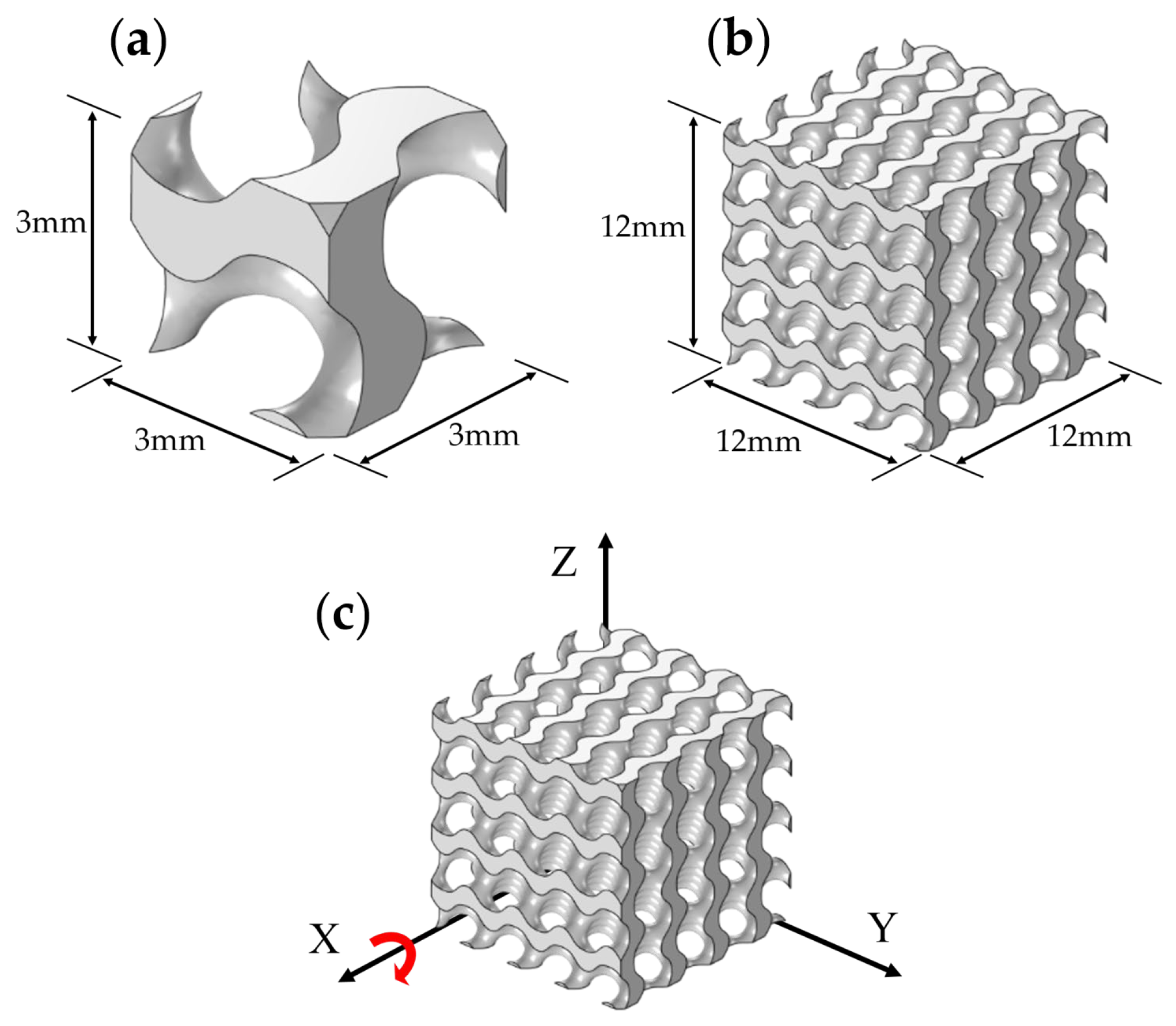
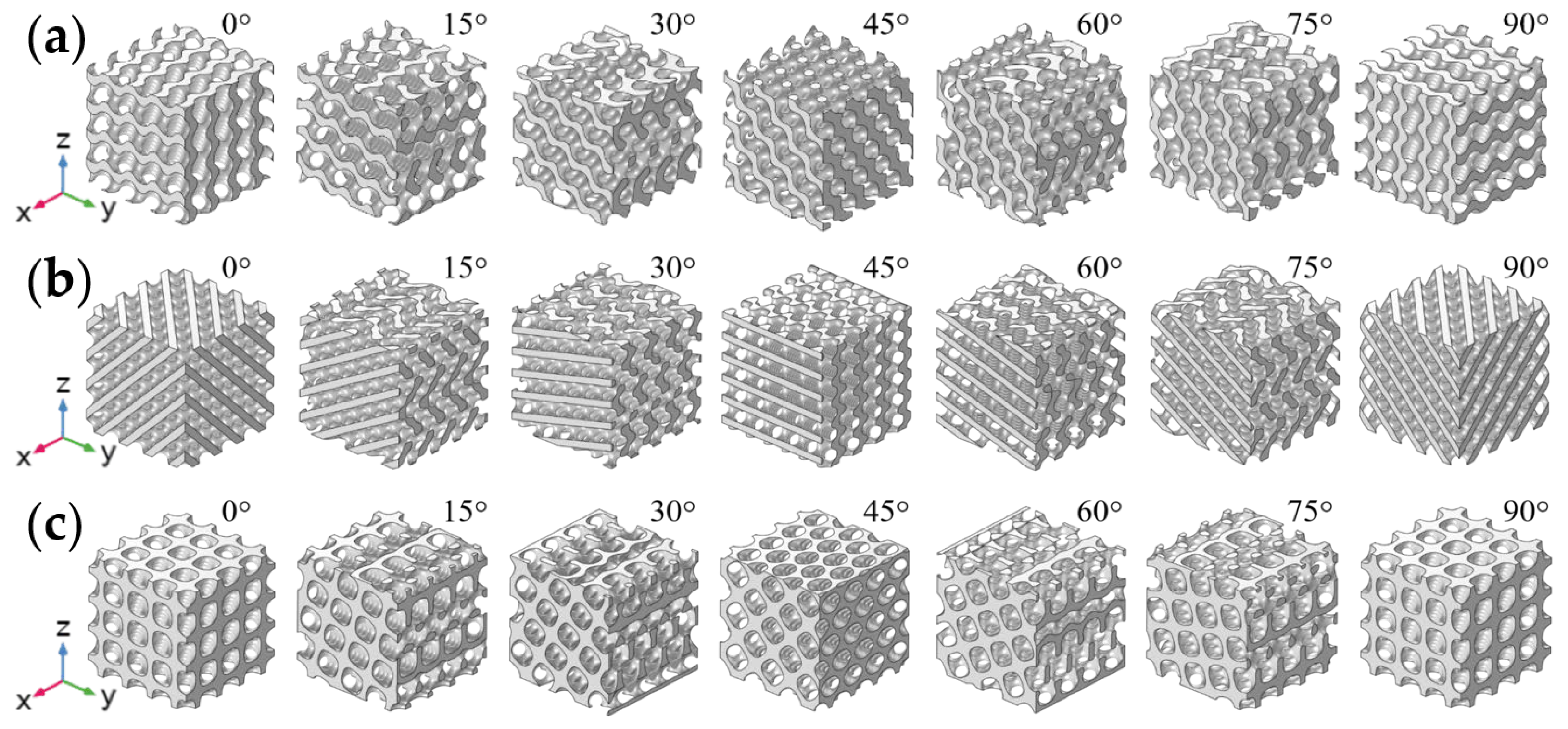
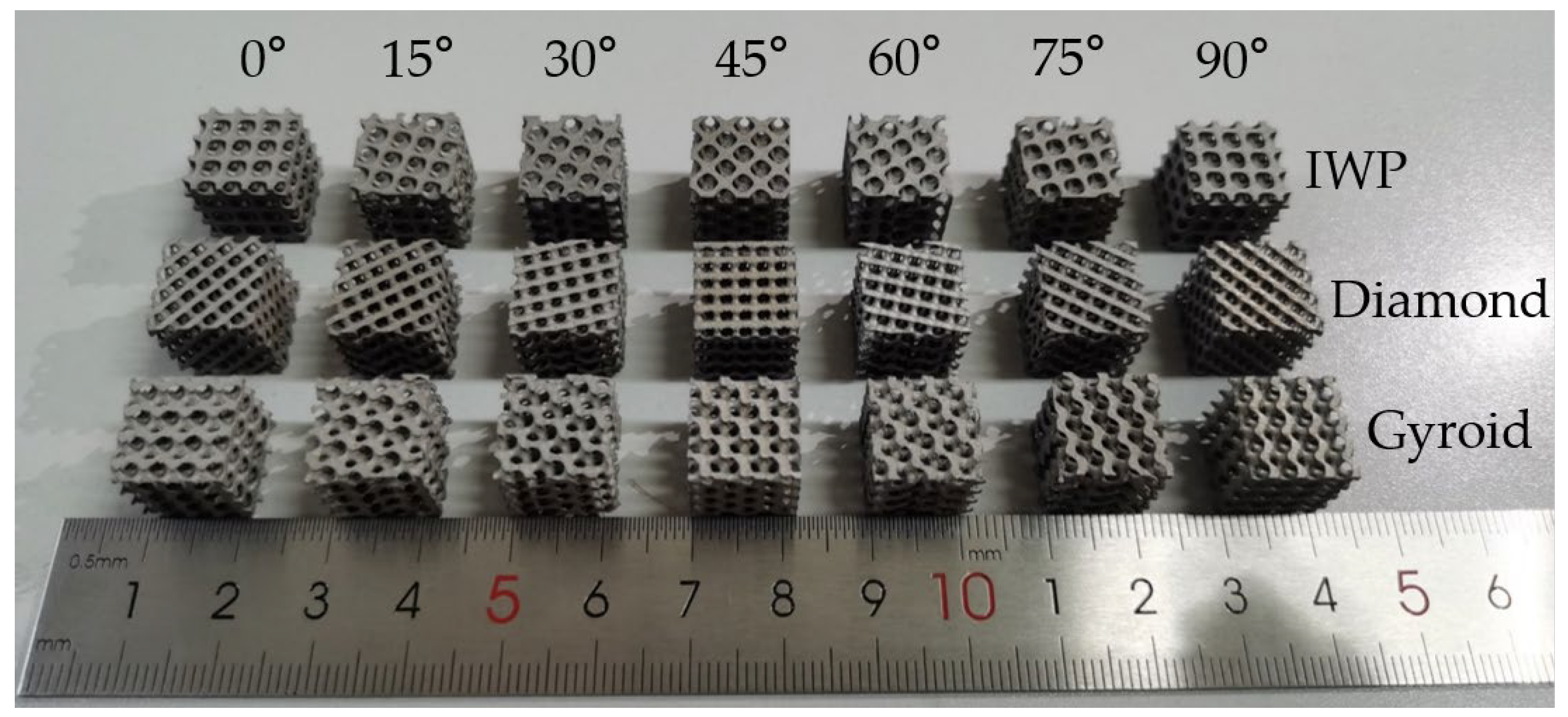
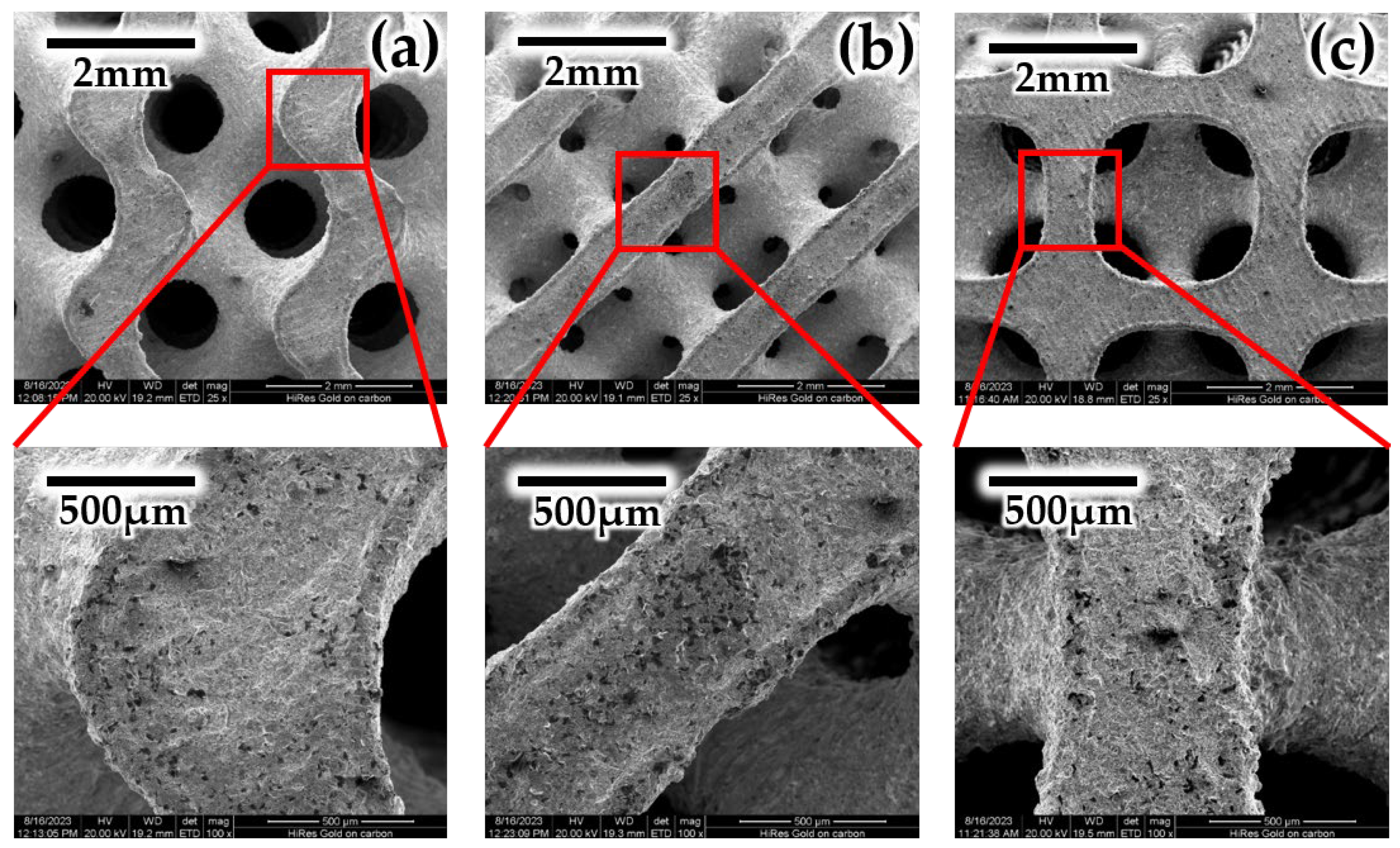
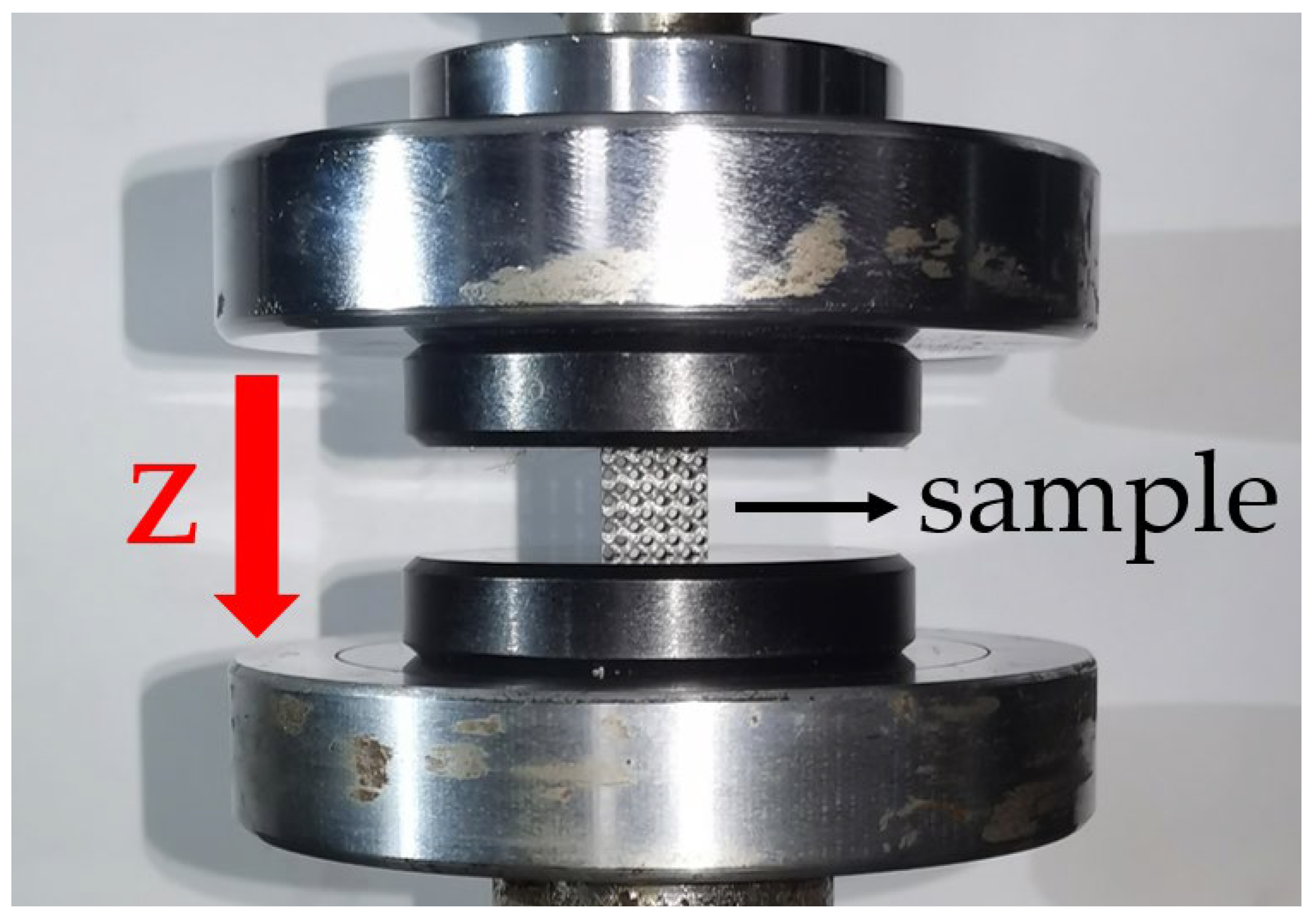
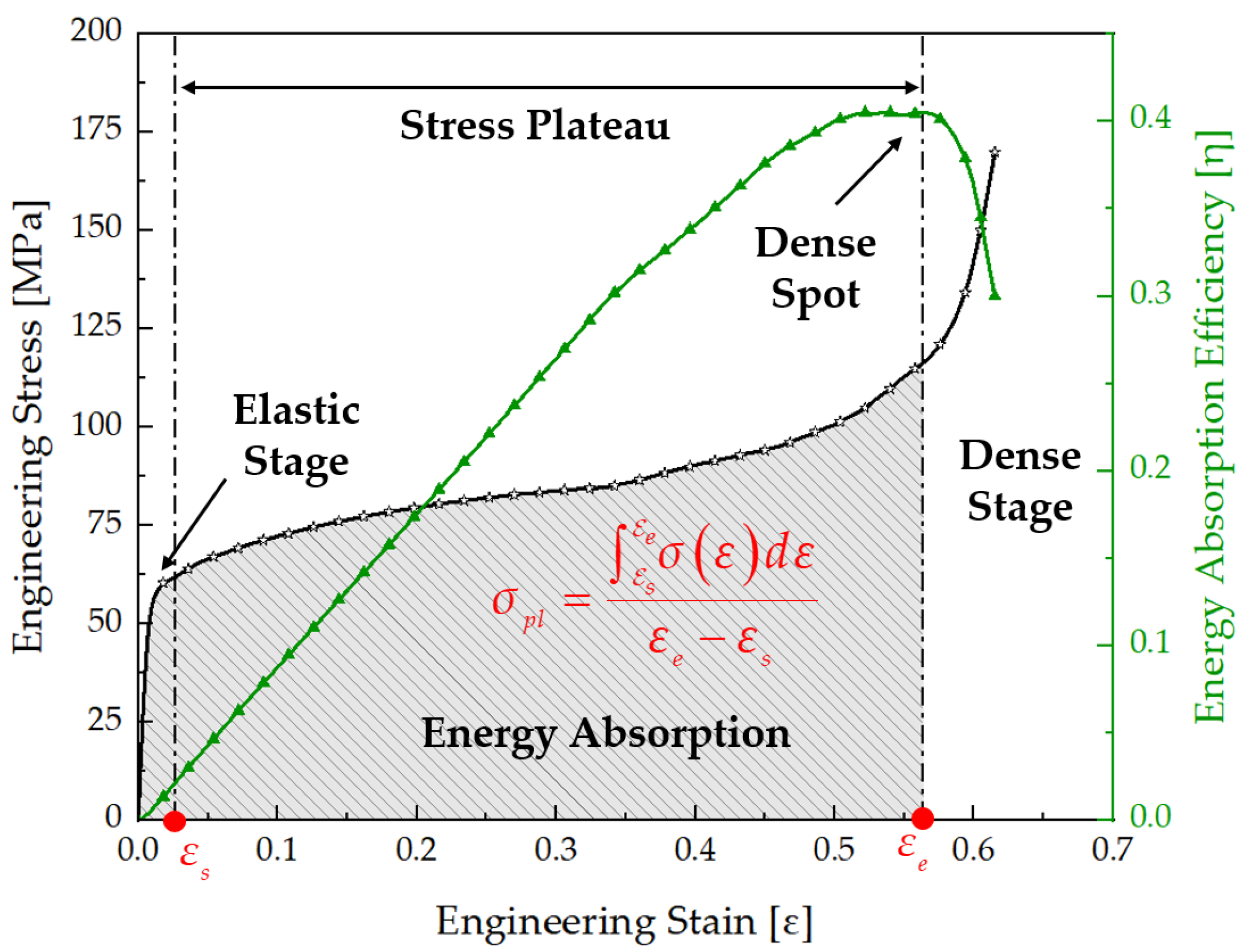
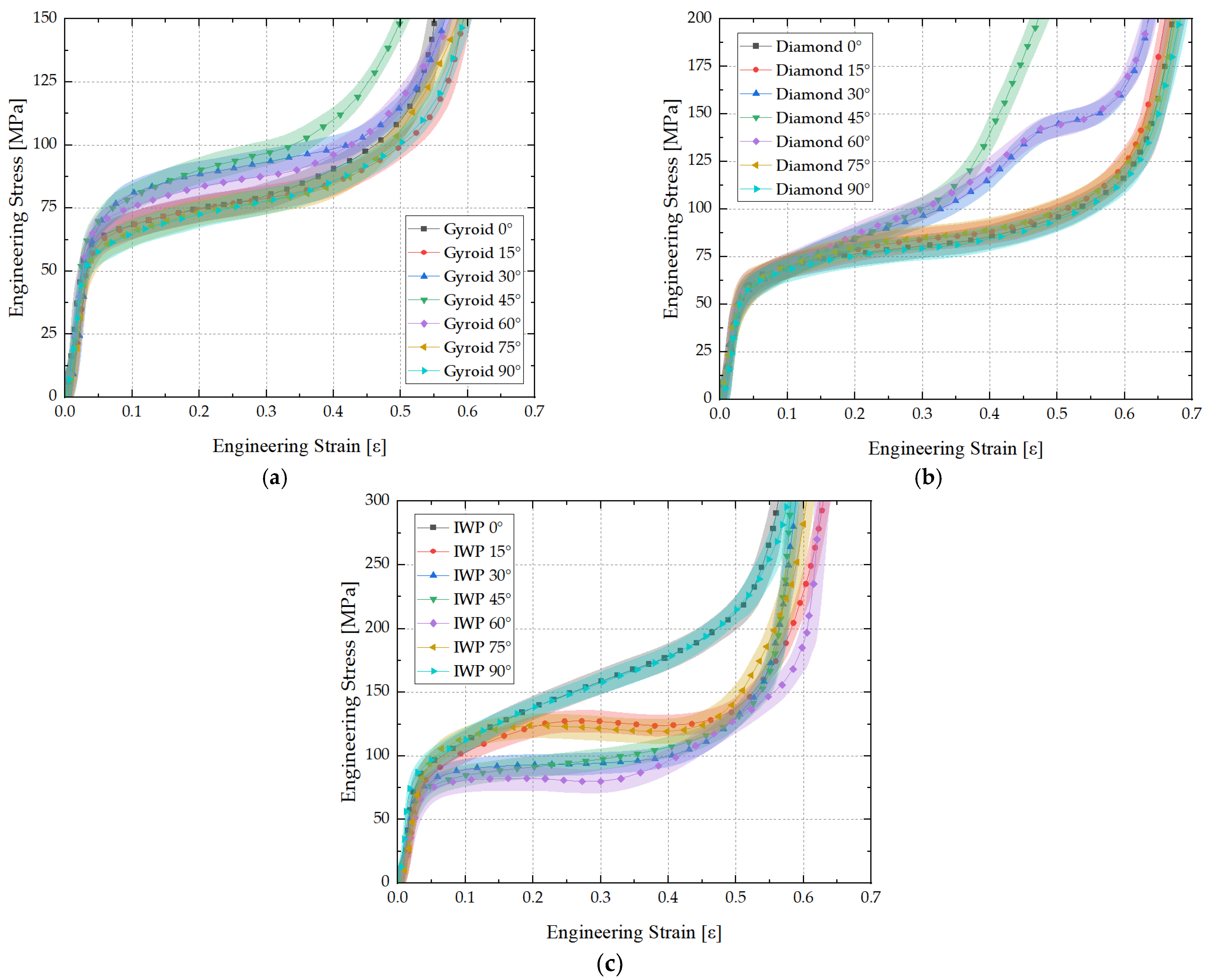

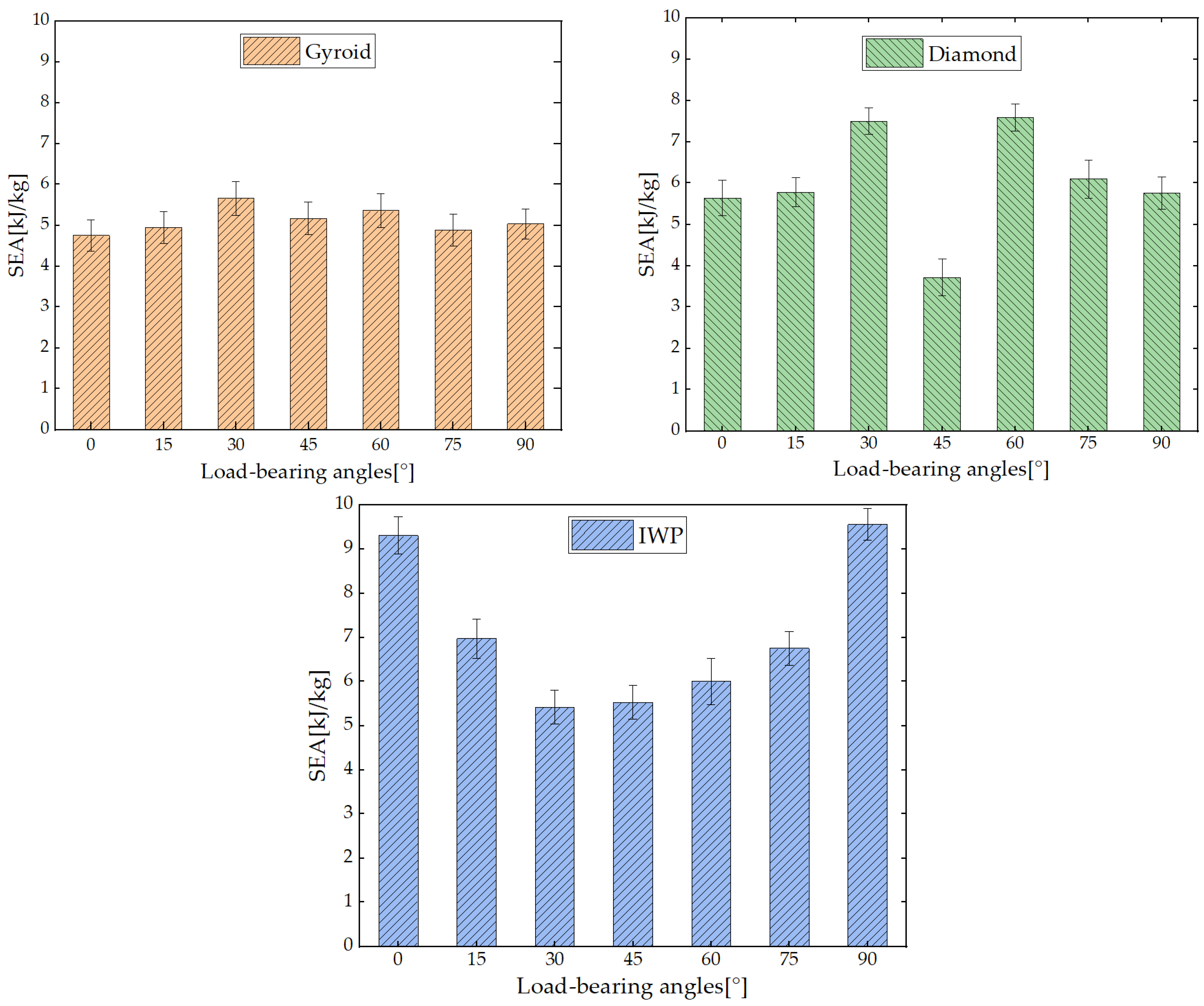
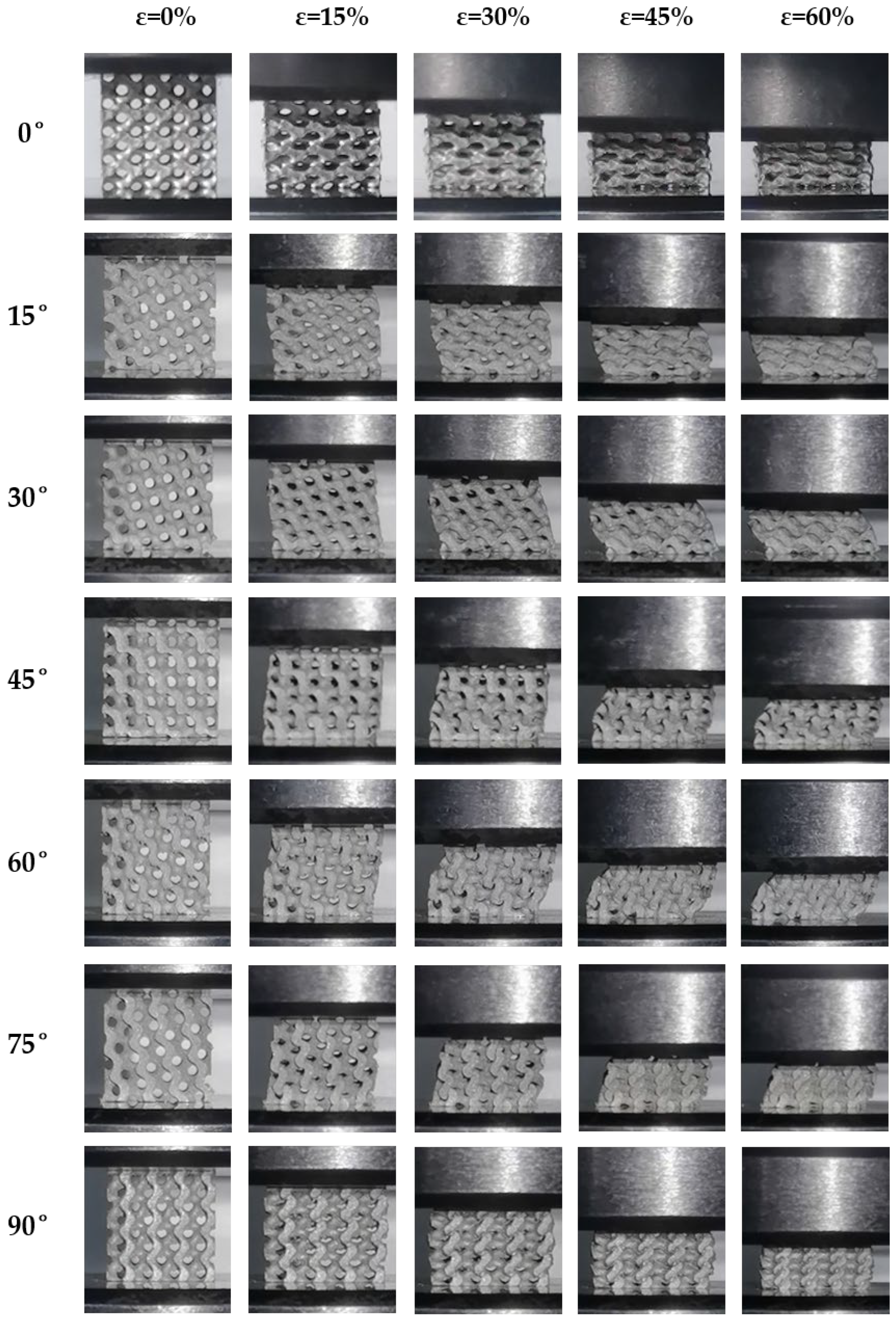
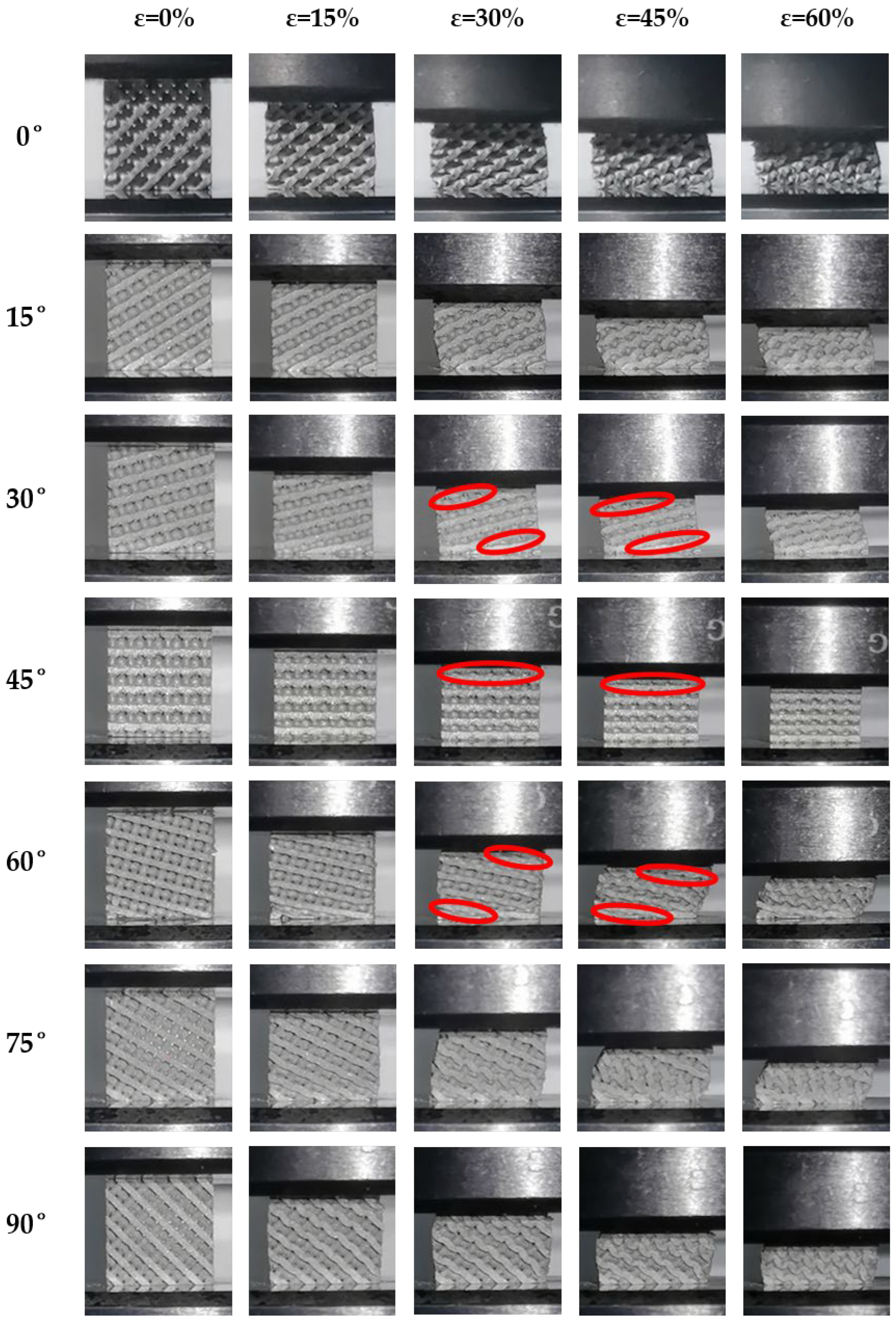

| Element | Fe | Cr | Ni | Mo | C | Other |
|---|---|---|---|---|---|---|
| Weight percent (%) | Balance | 18 | 12 | 2 | <0.03 | <1.0 |
| Young’s Modulus | Density | Poisson Ratio | Yielding Stress |
|---|---|---|---|
| 176 GPa | 7980 kg/m3 | 0.3 | 480 MPa |
| Laser Power | Layer Thickness | Scan Speed | Printing Environment |
|---|---|---|---|
| 140 W | 30 μm | 650 mm/s | Argon |
| Load-Bearing Angle | SEA (kJ/kg) | Densification Strain | Plateau Stress (MPa) |
|---|---|---|---|
| 0° | 4.75 ± 0.38 | 0.504 ± 0.036 | 80.34 ± 4.13 |
| 15° | 4.95 ± 0.39 | 0.524 ± 0.033 | 80.21 ± 3.89 |
| 30° | 5.66 ± 0.41 | 0.525 ± 0.035 | 93.75 ± 3.56 |
| 45° | 5.17 ± 0.40 | 0.461 ± 0.040 | 95.01 ± 4.07 |
| 60° | 5.36 ± 0.42 | 0.507 ± 0.038 | 88.95 ± 4.23 |
| 75° | 4.89 ± 0.39 | 0.493 ± 0.036 | 80.24 ± 3.93 |
| 90° | 4.92 ± 0.37 | 0.533 ± 0.037 | 79.96 ± 4.42 |
| Load-Bearing Angle | SEA (kJ/kg) | Densification Strain | Plateau Stress (MPa) |
|---|---|---|---|
| 0° | 5.64 ± 0.43 | 0.572 ± 0.032 | 82.49 ± 4.15 |
| 15° | 5.78 ± 0.35 | 0.570 ± 0.033 | 84.34 ± 4.23 |
| 30° | 7.50 ± 0.32 | 0.594 ± 0.035 | 105.95 ± 5.06 |
| 45° | 3.72 ± 0.45 | 0.370 ± 0.039 | 85.77 ± 4.57 |
| 60° | 7.59 ± 0.33 | 0.591 ± 0.032 | 107.12 ± 4.55 |
| 75° | 6.10 ± 0.46 | 0.589 ± 0.038 | 86.16 ± 4.98 |
| 90° | 5.76 ± 0.39 | 0.587 ± 0.041 | 81.74 ± 4.24 |
| Load-Bearing Angle | SEA (kJ/kg) | Densification Strain | Plateau Stress (MPa) |
|---|---|---|---|
| 0° | 9.30 ± 0.42 | 0.532 ± 0.037 | 152.88 ± 4.37 |
| 15° | 6.97 ± 0.44 | 0.499 ± 0.041 | 119.16 ± 4.18 |
| 30° | 5.42 ± 0.39 | 0.496 ± 0.036 | 93.97 ± 4.86 |
| 45° | 5.53 ± 0.38 | 0.498 ± 0.039 | 96.60 ± 4.54 |
| 60° | 6.04 ± 0.52 | 0.499 ± 0.044 | 95.86 ± 5.02 |
| 75° | 6.75 ± 0.38 | 0.492 ± 0.045 | 120.41 ± 4.73 |
| 90° | 9.55 ± 0.36 | 0.538 ± 0.032 | 153.97 ± 5.14 |
Disclaimer/Publisher’s Note: The statements, opinions and data contained in all publications are solely those of the individual author(s) and contributor(s) and not of MDPI and/or the editor(s). MDPI and/or the editor(s) disclaim responsibility for any injury to people or property resulting from any ideas, methods, instructions or products referred to in the content. |
© 2024 by the authors. Licensee MDPI, Basel, Switzerland. This article is an open access article distributed under the terms and conditions of the Creative Commons Attribution (CC BY) license (https://creativecommons.org/licenses/by/4.0/).
Share and Cite
Lyu, Y.; Gong, T.; He, T.; Wang, H.; Zhuravkov, M.; Xia, Y. Study on the Energy Absorption Performance of Triply Periodic Minimal Surface (TPMS) Structures at Different Load-Bearing Angles. Biomimetics 2024, 9, 392. https://doi.org/10.3390/biomimetics9070392
Lyu Y, Gong T, He T, Wang H, Zhuravkov M, Xia Y. Study on the Energy Absorption Performance of Triply Periodic Minimal Surface (TPMS) Structures at Different Load-Bearing Angles. Biomimetics. 2024; 9(7):392. https://doi.org/10.3390/biomimetics9070392
Chicago/Turabian StyleLyu, Yongtao, Tingxiang Gong, Tao He, Hao Wang, Michael Zhuravkov, and Yang Xia. 2024. "Study on the Energy Absorption Performance of Triply Periodic Minimal Surface (TPMS) Structures at Different Load-Bearing Angles" Biomimetics 9, no. 7: 392. https://doi.org/10.3390/biomimetics9070392






